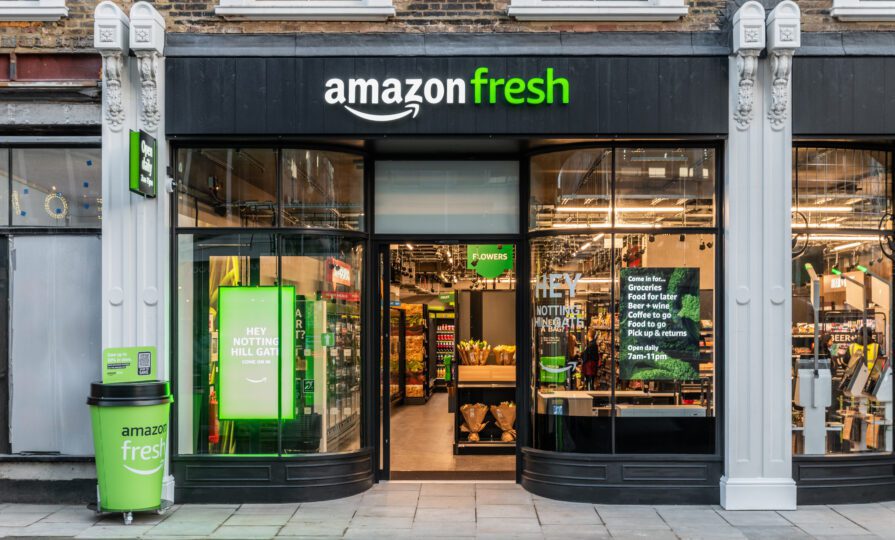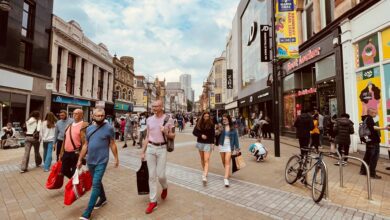Fresh no more: Amazon’s online grocery strategy explained
Amazon is set to close all its Fresh stores in the UK, shifting its focus to online grocery delivery and partnerships. Experts weigh in on why the in-store experiment struggled and what this strategic pivot means for the future of retail.

Register to get 1 free article
Reveal the article below by registering for our email newsletter.
Want unlimited access? View Plans
Already have an account? Sign in
Amazon has announced it will close all 14 of its Amazon Fresh stores in the UK, while converting a further five into Whole Foods Market locations. By the end of 2026, the company will operate 12 Whole Foods stores across the country, including a recently opened branch in Chelsea and another planned in Greater London.
While the news marks the end of Amazon’s experiment with physical grocery retail under the Fresh brand, the company is clear that this is a strategic pivot rather than a retreat. When the news was initially broken, country manager for Amazon UK John Boumphrey emphasised that the closures are part of a broader strategy to expand choice and convenience for customers, while supporting employees through the transition.
Amazon’s focus in the UK market is increasingly on online grocery, a segment that is growing rapidly. Its UK grocery and household essentials category expanded nearly twice as fast as other product categories in early 2025. Plans are already underway to extend perishable grocery offerings, including dairy, meat, and frozen foods, to same-day delivery on Amazon.co.uk, following the model recently introduced in the United States.
Amazon’s wider grocery delivery ecosystem is already extensive. In addition to Amazon Fresh and Whole Foods, it partners with Morrisons, Co-op, Iceland, and Gopuff, with more than 80% of UK Prime members soon able to access at least one grocery partner. Delivery speeds also continue to accelerate, reflecting Amazon’s focus on convenience and efficiency in the online space. In this context, the closure of physical Fresh stores is less a sign of failure than an indication of Amazon’s strategic realignment. That said, it also highlights the challenges any grocer faces in marrying technology with in-store retail.
Even with high-profile innovation like the “Just Walk Out” cashierless system, the Fresh stores struggled to convert curiosity into sustained adoption. Chris Jones, managing director at PSE Consulting, explains that while the concept promised a frictionless shopping experience, operational realities complicated execution.
“Errors such as mischarges, missed items, and other operational challenges eroded customer trust, requiring a significant back-office workforce and undermining the model’s scalability,” Jones says. “For UK shoppers, already familiar with self-scan and click-and-collect, the benefit wasn’t compelling enough to change established habits.”
The difficulty lay in translating futuristic concepts into everyday consumer behaviour. James Rigg, chief executive of Trojan Electronics, highlights that the stores’ tech-heavy approach was not intuitive to shoppers.
“Shoppers didn’t really understand the concept. You had to use your Amazon app to do your in-store shop, which didn’t sit well with traditional consumers. For younger, more tech-savvy shoppers, the stores themselves felt a bit clunky – they didn’t match what that audience expects,” Rigg adds. “The idea is incredible, but the execution didn’t land with any specific customer segment.”
From a supply chain perspective, operational constraints also limited Fresh’s impact. Maggie Allen, Senior Retail Labelling Executive at Loftware, says Amazon’s highly centralised logistics model was ill-suited to the rapid turnover needed for perishables. “Perishable goods require cold chain and fast turnover, coupled with Amazon’s centralised infrastructure doesn’t give them the responsiveness needed for fresh food distribution,” she explains. The result, she suggests, was a mismatch between Amazon’s strengths in packaged goods and the fast-moving, locally driven realities of fresh grocery retail.
Beyond logistics and consumer behaviour, the financial and operational realities of UK retail added further pressure. David Gilbert, fractional chief financial officer at The CFO Centre and former finance director of The White Company and Karen Millen, emphasises the sector’s vulnerability, saying: “Retail is one of the most unforgiving sectors. It operates on slim margins, is exposed to shifts in consumer habits, and is highly sensitive to inflationary pressures. Unless a physical location can deliver quick and measurable returns, boards should be cautious about setting up in new geographies.”
Consumer expectations create a further balancing act. James Westoby, EMEA chief executive of VML Enterprise Solutions, highlights that convenience alone is not enough.
“Despite the closure of Amazon Fresh stores across the UK, we know that modern shoppers want convenience above all else – and concepts like Amazon Fresh are central to improving the retail experience,” Westoby points out. “In 2025, shoppers expect a seamless journey where the digital and physical worlds aren’t just connected – they’re synchronised, and this has to be reflected across all channels and touchpoints.”
However, research from the Belonging Forum points in the opposite direction. Its findings reinforce the importance of human interaction in-store: nearly half of UK adults are more likely to return to stores where they are served by a person rather than an automated checkout. According to its survey pool, 60% also prefer stores where they can ask questions or engage with staff.
Kim Samuel, founder of the Belonging Forum, explains, “Small, everyday interactions – whether a kind word at the till or simply sharing a joke – are vital for building social connection. A conversation at a supermarket checkout could be the only meaningful interaction older people and people with disabilities in particular have all day.”
In spite of these hurdles, Amazon’s pivot toward online grocery is a deliberate move that leverages the company’s strengths in data, logistics, and partnerships. Jones frames the closure of physical stores as a recalibration.
“The stores have generated a uniquely rich dataset: billions of behavioural insights into how people shop. This data can now be used to train GenAI models and test future in-store technologies, including innovations like the Dash Cart, at a fraction of the cost competitors would face,” he points out. “Amazon, equipped with unparalleled behavioural data, is well positioned to re-enter physical retail in the future with a more robust, AI-enhanced model.”
From Allen’s perspective, the pivot also highlights the centrality of logistics as a differentiator. “What we see here is the importance of logistics and fulfilment as a differentiator in grocery retail,” she says. “Brick and mortars rely more on branding, merchandising and store experience, where online relies more on fulfilment, speed and accuracy. Supply chain efficiency, logistics and technology will be what sets online grocers apart.”
Tom Purton, a lawyer working with nationwide and online grocers, agrees that the decision “plays to Amazon’s strengths in scale and logistics”.
“By leaning into partnerships with Morrisons, Co-op, and others, it reinforces a trend we’re seeing across the sector – that delivery and click-and-collect will remain central to the grocery offer in the decade ahead,” Purton adds.
Gilbert agrees that online expansion offers more immediate financial and operational impact in a cash-constrained environment. “Online expansion often offers greater flexibility and scalability than opening new stores. Marketing, digital platforms, and customer experience online can often deliver more immediate impact with less risk.”
Yet all experts caution that physical retail is not going away. Rigg explains that while online grocery works well for staples, fresh food remains an inherently emotional and tactile experience.
“For the next five to 10 years, hybrid models will dominate. With ongoing improvements in fast, convenient home delivery, fresh food is also an emotional purchase,” Rigg says. “People’s appetites aren’t formulaic – often you want to walk the aisles, see what’s available, and let something inspire you in the moment. That sense of discovery still can’t be replicated in an app.”
Amazon’s experience offers clear lessons for other retailers. Gilbert stresses the importance of strategic discipline and risk management, saying, “Expansion should be pursued cautiously, with decisions rooted in facts rather than ambition, and growth must be sustainable, with investments showing a realistic path to payback. Boards must remain vigilant, asking difficult questions and resisting the temptation to expand for expansion’s sake.”
Allen agrees, adding that traditional grocers can learn from Amazon’s logistical growing pains. “Supply chains are king,” she says. “Digitally, you have a larger reach – if you have the right fulfilment strategies in place.”
Operational and technological considerations are equally important. Purton and Rigg both highlight the necessity of getting the fundamentals right while continuing to innovate. Their view boils down to a combination of convenience, price, product range and supply chain efficiency, with a healthy measure of experimentation.
Jones concludes by emphasising the enduring value of Amazon’s in-store experiment, not as a failure, but as a foundation for the future. He adds, “The smarter approach is to leverage data-driven digital simulations before scaling, learning from consumer behaviour and edge cases to ensure new in-store technologies truly enhance, rather than frustrate, the shopping experience.”
In the end, the closure of Amazon Fresh stores may mark the end of a high-profile experiment in physical retail, but it also demonstrates how a global brand can recalibrate to play to its strengths. By leveraging its online infrastructure, partnerships, and the behavioural data generated from its stores, Amazon is positioning itself to invent its own future in the grocery retail space – and, potentially, to return to physical stores in a smarter, more AI-driven form later down the line.







